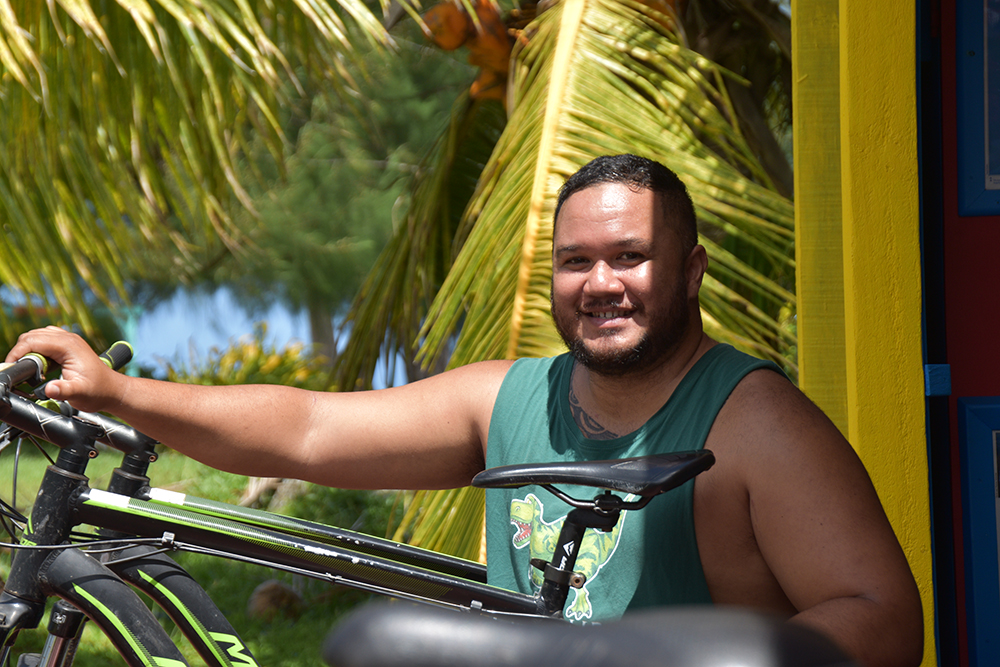Dive centre ready for adventure
Saturday 29 January 2022 | Written by Supplied | Published in Features, Weekend

Adventure Cook Islands co-owner Sean Wichman gets the gears ready. AL WILLIAMS/22011430
Rarotonga-based Adventure Cook Islands have started welcoming divers back once again following a long break due Covid-19 related border closure.
It has been a rather challenging and interesting 20 months for PADI dive centre Adventure Cook Islands. Finally, after many months of closed borders, the Cook Islands are once again open to visitors from New Zealand.
Just as the travel world came to a halt in April 2020, the dive centre had to relocate its premises.
Patrick Jaletzky, Adventure Cook Islands’ director of sea operations, says after 11 years of successful operation, they had to say goodbye to their original location in Kavera on the west coast of Rarotonga.
Despite the fact that their new location was only 800 metres down the road, relocating the entire business including the buildings turned out to be a major task.
“There are not many options when it comes to moving buildings on a small tropical island. With limited machinery options, equipment has to be made up on the spot and improvising is often required. Even though we hired professionals to help with the building relocation works, we were very much involved in the jacking up and moving of our buildings,” Jaletzky told scubadivermag.com.
“After a few nerve-racking but rewarding weeks, the main buildings were relocated and we were left to ourselves, with lots of building repair and touch up work.”
With the Cook Islands borders shut, Jaletzky says the dive centre team had lots of time at hands to complete all the work and they were more than pleased with the end result.
“Even though we did not relocate our business by choice, moving the business to our new location by Aroa Beach on the south – west corner of the island turned out to be a great decision. Not only do we now have a lot more space and a fantastic, big workshop, we are also situated right in front of the beautiful Aroa ra’ui (marine protected area), one of the best places for snorkelling inside Rarotonga’s lagoon. In addition, we are now next door to the Rarotongan Beach Resort, one of the major hotels on the island.”
The Aroa lagoon, with its interesting marine life, is not only perfect for snorkelling, but also very good for scuba diver training.
Jaletzky says they literally only have to walk across the road for their confined water training and shallow Discover Scuba Dives.
“Since we relocated to Aroa Beach, we have also extended our range in diving services. We now cater for rebreather divers and stock soda lime, oxygen and helium for the experienced mixed gas CCR diver.
“Apart from rebreather trips and training, we also offer discovery dives for those who do not want to commit to a full rebreather course but still want to find out what diving is like with a rebreather.”
During the border closure the dive centre also became a supporting partner of the Cook Islands environmental non-governmental organisation Kōrero o te ‘Ōrau. The organisation’s aim is to protect the Cook Islands culture, environment and natural resources. Its name translates to “knowledge of the sky, land, and sea”. Their programme Ātui'anga ki te Tango (AKTT) teaches students life skills and traditional practices.
“We supported the organisation by training AKTT senior students to PADI Open Water Diver level and helped students develop fundamental skills to become our next generation of ocean ambassadors.
“In a country with a territory consisting mainly of water, getting the youth interested in ocean education is the way forward to a more sustainable future.”
Rarotonga’s coral reefs are beautiful and healthier than they have been in a long time. However, since the beginning of 2020, Jaletzky says they have been observing elevated numbers of Crown-of-thorns starfish on parts of the reef.
Crown-of-thorns starfish have evolved over millions of years and are beautiful, natural reef predators. They feed preferably on corals and are important for the natural growth and health of the coral reef. However, in great numbers, they can become highly destructive.
“As soon as we finished relocating our business buildings and had our compressor up and running again, our dive centre started to work alongside Kōrero o te ‘Ōrau, the Ministry of Marine Resources and many local volunteers to control the islands Crown-of-thorns starfish population.
“Over the period of 18 months, thousands of starfish have been removed to keep the population within levels that are sustainable for the reef. Efforts are ongoing, but well worth it.”
- Scubadivermag.com




































